Star Trek: The Animated Series
By Philip Schweier
April 16, 2012 - 09:50
In 1973, four years after Star Trek was
cancelled by the NBC network, a new version of the series reunited the crew of
the starship Enterprise. A half-hour
animated version debuted on CBS on Sept. 8, 1973. Produced by Filmation, the
series ran for two seasons, 22 episodes in all.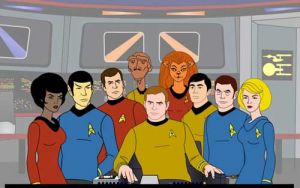
The crew of the animated Enterprise
According the website danhausertrek.com, Lou Scheimer, an executive
at Filmation, saw the potential in Star Trek as an animated series
and approached Star Trek creator Gene Roddenberry. While the animation
company came up with several ideas to make such a show more kid-friendly for
the Saturday morning audience, Roddenberry had higher aspirations.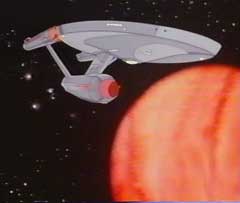
The animated enterprise in orbit
For the most part, the animated series is not regarded as part of the Star Trek
canon. Some sources, such as IMDB.com, report that at the time, Roddenberry
never expected the series to return in any form. As a result, he allowed the
writing staff a wide latitude.
As consulting producer, Roddenberry brought long-time Star Trek producer
D.C. Fontana on board. Under her guidance, a number of ambitious scripts were
shepherded through the process of being made suitable for a 22-minute animated
episode. Many were written by better writers than Saturday morning usually
permits, such as science fiction author Larry Niven and veteran Star Trek scribe David Gerrold.
Actor Walter Koenig, who portrayed Ensign Pavel Chekov on the original series,
also contributed a script. Though he wrote the animated episode The Infinite Vulcan, Koenig was not
among the cast members to be reunited for the animated series.
According to IMDB.com, the series was originally going to feature only
William Shatner, Leonard Nimoy, DeForest Kelley and James Doohan reprising
their roles. Other supporting characters, such as Lt. Uhura and Lt. Sulu, were
going to be recast. Allegedly, when Nimoy learned this, he held out, insisting
Nichelle Nichols and George Takei be offered their original roles. One claim is
that Nimoy felt their ethnic diversity contributed to the scope of Star Trek’s
philosophy. Nichols and Takei were cast, but budget constraints reportedly
prohibited Koenig from being added to the animated series.
In his stead, a new character, Lt. Arex, was created. Arex, a
member of the Edoan people, was a skeletal figure with reddish skin and six
limbs. Another new crew member was Lt. M’Ress, voiced by Majel Barrett. A
secondary communications officer, she was feline in appearance, as a member of
the Caitian race.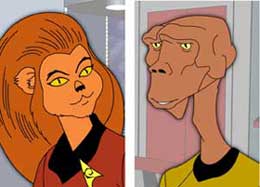
Otherwise, all of the original cast was brought back to reprise
their respective roles, as well as play additional characters as needed.
Doohan, who was capable of a variety of accents, provided many voices,
including that of Lt. Arex. Barret voiced many female characters.
Other familiar voices appeared as guests in some episodes. The second in the
animated series, Yesteryear, saw Spock journey back in time to his
boyhood on Vulcan. Mark Lenard reprised his role from the original series as
Spock’s father, Sarek. Two other actors, Roger C. Carmel and Stanley Adams,
repeated their roles as Harry Mudd and Cyrano Jones, respectively.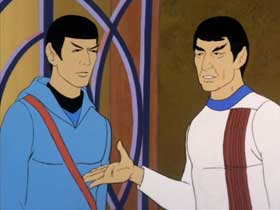
Sarek welcomes an incognito Spock into his home
One of the benefits of the animated series was it permitted a much
wider scope of design and special effects. Many designs, such as ships and
costuming, were very consistent with that of the original series. However, some
elements were conceived out of convenience. One example is the life support
belts used by crewmembers. Rather than wear some form of environment suit, the
belts generated a yellow protective force field around the person. This
permitted the animators to re-use established character designs, and sometimes
stock footage. Given the shows budgets of upwards of $75,000 per episode, such
shortcuts were often necessary.
In fact, Filmation was notorious throughout the 1970s for re-using stock
footage on many of its productions. In the case of Star Trek, there
were some shots in which animators failed to remove a character from a scene.
For instance, there are a couple of scenes in which a crew member is on a
planet’s surface communicating with the bridge of the Enterprise, only to be shown on the bridge in the next shot.
Nevertheless, the series won an Emmy Award for Best Children’s Program in 1974.
Though Roddenberry did not regard the animated series as part of Star Trek
canon, many elements were later picked up, most notably Captain Kirk’s middle
name (Tiberius), revealed by Gerrold in his script, Bem. A second season
episode, The Practical Joker, introduced the recreation deck, a
holographic room capable of creating any kind of environment desired. This
later became a popular setting on Star Trek: The Next Generation.
The scripts of the animated series were collected and adapted by
writer Alan Dean Foster, published as a 10-book “Log” series in the 1970s.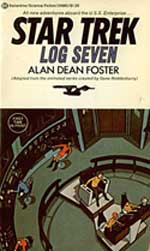
While the many novels published over the years have never been declared to be
part of the Star Trek Universe or not, popular Star Trek author Peter David
incorporated Lt. Arex and Lt. M’ress into his stories.
Now, almost 40 years later, the series still holds up in some ways, but
not in others. It was typical Saturday morning fare for its time, but the cast
and writers of the series deserve some credit for attempting to maintain the quality
of the original series – which admittedly was uneven – in a rather limiting
format.
Images courtesy of startrekanimated.com.
For lots more on the animated Star Trek Series, visit Kail Tescar's
website.
Praise and adulation? Scorn and ridicule? E-mail me at philip@comicbookbin.com
Related Articles:
Star Trek: Waypoint TPB comics review
Star Trek Into The Darkness Trailer
Star Trek The Next Generation: Hive #1 Review
Star Trek: The Next Generation/Doctor Who Assimiltion #4 Review
Star Trek: The Animated Series
Paramount Digital entertainment unveils Star Trek
Star Trek Captain's Log iPhone Communicator App Now Available
Star Trek: Alien Spotlight: Q
Star Trek: Intrepid - Episode 4 - Transitions and Lamentations
Star Trek: Intrepid - Episode 3 - Turning Point
